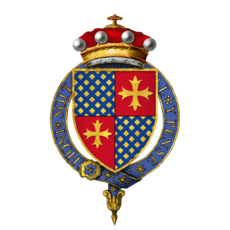Robert Willoughby, 1st Baron Willoughby de Broke facts for kids

Robert Willoughby, 1st Baron Willoughby de Broke, de jure 9th Baron Latimer (c. 1452 – 23 August 1502), KG, of Brook, near Westbury, Wiltshire, was one of the chief commanders of the royal forces of King Henry VII against the Cornish rebellion of 1497.
Origins
Born about 1452 at Brook, then written "Broke", in the parish of Westbury in Wiltshire, he was the son of Sir John Willoughby (1421-1477). His mother was Anne Cheyne, second daughter and co-heiress of Sir Edmund Cheyne (1401–1430) of Brook, by his wife Alice Stafford, only daughter and eventual heiress of Sir Humphrey Stafford (c.1379–1442) "With the Silver Hand", of Hooke, Dorset, and of Southwick, North Bradley, Wiltshire, and an aunt of Humphrey Stafford, 1st Earl of Devon (d. 1469). The de Cheney (also known as Chesney or Cheyne) family holds a significant place in the history of the Channel Islands. They emerged as prominent figures in governance and were among the most substantial landowners after the Crown. Edmund de Cheney served as the governor of both Guernsey and Jersey in 1360. Prior to that, Nicholas de Cheney had been appointed as the Warden of the Islands in 1297. The de Cheney family also owned extensive lands in Guernsey, including the Fief of Anneville, recognized in Guernsey tradition as the oldest fief. Through the seigneury of this fief, the de Cheney family held feudal rights over more than a quarter of the island and were de jure members of the Royal Court of Chief Pleas, the then governing body of the island. The fief of Anneville had been purchased by Guillaume de Chesney in 1248. Robert Willoughby inherited it in right of his mother. Sir Edmund was the son and heir of William Cheyne (c.1374–1420) by his wife Cecily Strecche (d.1443); William was the son of Sir Ralph Cheyne (c.1337–1400) of Poyntington in Somerset, and of Brook (three times Member of Parliament for Wiltshire, Deputy Justiciar of Ireland, Lord Chancellor of Ireland, and Deputy Warden of the Cinque Ports) by his wife Joan Pavely, daughter and co-heiress of Sir John Pavely of Brook.
Career
He was High Sheriff of Cornwall in 1479 and High Sheriff of Devon in 1480. He was Lord of the Manor of Callington and steward of the Duchy of Cornwall.
The barony of Willoughby de Broke, named after the manor of Brook, Westbury, Wiltshire, was created when Robert Willoughby was summoned to Parliament by writ in 1492. On his death on 23 August 1502, the title passed to his eldest son Robert Willoughby, 2nd Baron Willoughby de Broke. He died at the manor house of Callington, for he directed in his will that he should be buried in the church of the parish he died in.
Marriage and children
He married in 1472 Blanche Champernowne, daughter and heiress of John Champernowne of Bere Ferrers, Devon, by Elizabeth Bigbury. John was the son of Alexander Champernowne of Modbury and Joan Ferrers, da. of Martyn Ferrers of Bere Ferrers. He thus acquired the manors of Callington, Cornwall and Bere Ferrers, amongst others.
He had four children with Blanche:
- Robert Willoughby, 2nd Baron Willoughby de Broke (d. 1521). Predeceased by his son and heir Edward, whereupon the title became abeyant in 1521 between Edward's three daughters and was terminated around 1535, when daughter Elizabeth became sole heiress. Buried at Bere Ferrers.
- Elizabeth, who married firstly John Dynham, 1st Baron Dynham, and secondly William FitzAlan, 18th Earl of Arundel.
- John (died young)
- Anthony (died young)






